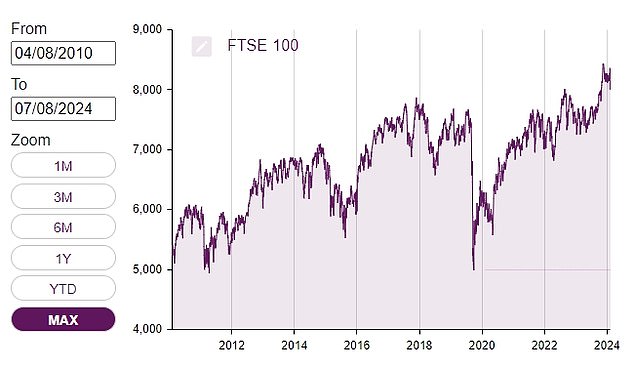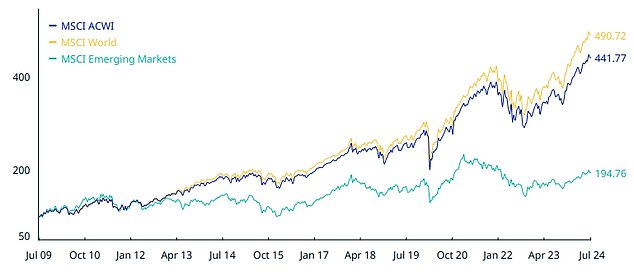Markets have a tendency to panic, but you shouldn’t: SIMON LAMBERT
I checked my shares and Isa bonds last Friday morning and all was well.
Monday afternoon I went to check again and it looked considerably worse.
Markets plunged on both sides of the weekend due to poor US employment figures and the lack of a Federal Reserve rate cut, as well as frequent panics in the Japanese yen and the stock market.
That didn’t do my Isa investments any good, but the biggest mistake I made was looking in the first place.
Riders on the storm: It may not be the huge surf of Nazare, but investors should channel their inner big wave surfer and stay calm as they ride the market’s waves
Even in the best of circumstances, there is a risk that you could be guilty of bad investment behavior if you monitor your investments two trading days in a row.
If you do this knowing that the market is in a downturn, you are tempting fate big time.
Fortunately, I was able to resist the temptation to tinker: selling items that had declined in value, switching to “safer” investments after the horse foundered, and so on.
When I had a quick look on Monday – and I shouldn’t have done that – I saw that the damage was a few thousand pounds off my wallet.
But that’s just theoretical damage. I know I’m investing for the long term and consider myself someone with a relatively high tolerance for investment risk, so I’m happy to be 100 percent in stocks.
And although my shares and bonds in Isa are not yet back to the levels of last Thursday, they have at least benefited from the recovery since Monday.
Markets don’t rise in a straight line and there will always be days when prices fall significantly. So I expect that to happen and I’m prepared to sit it out. I should use days like Monday as an opportunity to buy stocks while they’re on sale.
And yet that nagging doubt remains.
The voice in your head that says, ‘What if this is the big one? Wouldn’t it be better to get out now?’
As an investor, it is important to ignore that voice and pay attention to its existence.
You should ignore it if it encourages you to make hasty decisions, but you should also recognize that it is so loud that it causes stress. This indicates that you are not happy with your investment risk and that it may be wise to reduce it at a calmer and more sensible time.

The FTSE 100 is far from the best performing stock market in recent years and has seen some ups and downs, but has shown long-term share price growth
Sharp declines worry investors, but corrections are normal for markets. Some of the biggest declines in history fade into relative insignificance on long-term charts, especially when you look at total returns and not just stock prices.
The FTSE 100, for example, is far from the best performing stock market of the past 25 years and has certainly suffered some big falls since the dotcom bust. But trying to be smart and selling into one of those dips and missing the rebound would cost investors dearly.
In the meantime, look at the FTSE 100’s total return and things are looking much better than the sloely share price-based index. In share price terms the FTSE 100 is up just 11 per cent over five years, but on a total return basis it is up a much more respectable 33 per cent.
If you only invest in the FTSE 100, you are obviously doing something wrong.
The UK market represents just 3.4 percent of the global stock market, as measured by the MSCI All Countries World Index. That is less than Apple (4.35%), Microsoft (3.94%) or Nvidia (3.91%).
This means that UK investors need to be careful to avoid home bias, or they will be betting big on the UK stock market. Global investing, on the other hand, has delivered much better returns, with the MSCI ACWI index up 77 per cent in five years.
The declines disappear much faster when you look at the long-term chart of the global stock market.
The most important thing for investors is to avoid panic moves, which can lead to them selling their stocks at a low point and missing out on a recovery.

Zoom Out: Past 15 years of total returns for the MSCI indices: ACWI includes developed and emerging markets; World is developed markets only; Emerging markets is those only
Six tips for investors who want to calm their nerves
Do nothing: Not reacting to market sell-offs is usually the best course of action. Studies repeatedly show that individual investors succeed in underperforming stock markets because they tend to react poorly, selling when stocks are low and buying when they are high.
Do not constantly check: Investing is a long-term thing, so checking daily is a recipe for trouble. If you check your portfolio and feel compelled to take action, don’t do it right away. Take a step back, discuss what you’re going to do with someone, or write it down – evaluate it carefully and consider whether it’s the right move.
Acknowledge your emotions: Greed and fear are the emotions that drive reckless investment behavior, but it is natural to feel them. Accept that these feelings are inherent to being human when you see markets falling—or rising—but remember that you can control whether you react.
Don’t put all your eggs in one basket: Investors are told to diversify for a reason. A diversified portfolio will still go down, but it can protect you when market storms come. Don’t be overexposed to one stock, fund, sector or market. And remember, owning ten companies that do similar things is not diversification.
Invest regularly and think long term: Regular monthly investing allows you to build your portfolio steadily and avoid sudden market fluctuations that can affect invested amounts. Studies show that the longer you invest, the less likely you are to lose money over a period of time.
Be brave when others are afraid: Think of market declines as an opportunity to buy investments at lower prices. Turn it around and think of it as a stock market selling off instead of your investments being in a slump.
Some links in this article may be affiliate links. If you click on them, we may earn a small commission. That helps us fund This Is Money and keep it free. We do not write articles to promote products. We do not allow commercial relationships to influence our editorial independence.

